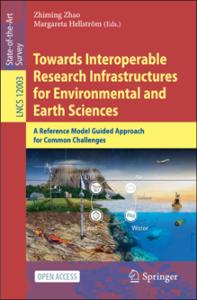| dc.contributor.editor | Zhao, Zhiming | |
| dc.contributor.editor | Hellström, Margareta | |
| dc.date.accessioned | 2022-07-04T16:47:16Z | |
| dc.date.available | 2022-07-04T16:47:16Z | |
| dc.date.issued | 2020 | |
| dc.identifier.citation | Zhao, Z. and Hellstrom, M. (2020) Towards Interoperable Research Infrastructures
for Environmental and Earth Sciences: a Reference Model Guided Approach for Common Challenges. Cham, Switzerland, Springer, 374pp. DOI: https://doi.org/10.1007/978-3-030-52829-4 | en_US |
| dc.identifier.uri | https://repository.oceanbestpractices.org/handle/11329/1975 | |
| dc.description.abstract | This book summarises the latest developments on data management in the EU H2020
ENVRIplus project, which brought together more than 20 environmental and Earth
science research infrastructures into a single community. It provides readers with a
systematic overview of the common challenges faced by research infrastructures and
how a ‘reference model guided’ engineering approach can be used to achieve greater
interoperability among such infrastructures in the environmental and Earth sciences.
The research problems behind environmental and societal challenges such as
climate change, food security, and natural disasters are intrinsically interdisciplinary.
Modelling these processes individually is difficult enough, but modelling their interactions
is another order of complexity entirely. Scientists are challenged to collaborate
across conventional disciplinary boundaries, but must first discover and extract data
dispersed across many different sources and in many different formats. Effective
research support environments are needed for various user-centralised research activities,
from formulating research problems to designing experiments, discovering data
and services, executing workflows, and analysing then publishing the final results.
Such support environments also have to manage research data during their entire
lifecycle, throughout the phases of data acquisition, curation, publication, processing,
and use. Moreover, support environments must support the management of underlying
infrastructure resources for computing, storage, and networking. In this ecosystem,
research infrastructure (RI) is an important form of supportive environment that bridges
the gap between the curation of research data and user-centred scientific activity, and
also between research data and the underlying physical infrastructure. It brings together
facilities, resources, and services used by the scientific community to conduct research,
establish best practices for science, and foster innovation.
This book presents the design, development, deployment, operation, and use of
research infrastructures as 20 chapters via five parts. Part one provides an overview
of the state of the art of research infrastructure and relevant e-Infrastructure technologies,
part two discusses the reference model guided engineering approach, the third
part presents the software and tools developed for common data management challenges,
the fourth part demonstrates the software via several use cases, and the last part
discusses the sustainability and future directions.
The main readers of the book will be developers, managers, operators, and potential
users of research infrastructures in environmental and earth sciences. This book will
provide RI data managers in environmental and earth sciences with a common ontological
framework and facilities for modeling data management requirements and
practical data management guidelines during entire research life-cycle. It will provide
RI stakeholders with very practical case studies on RI architecture design, service
interoperability, and system-level environmental research. The book can also be a
textbook for training young researchers and data managers in data management skills, RI service development and operation practices, and using RIs for data-centric
research.
In addition to researchers and developers involved in the data for science theme, the
development of the book has also been greatly supported by the project coordinator and
RI partners, in particular those specialists willing to serve in the editorial board. We
thank all the authors for contributing to the individual chapters, and reviewers for
providing valuable feedback on the content. Without their support, this book would not
have been possible. | en_US |
| dc.language.iso | en | en_US |
| dc.publisher | Springer | en_US |
| dc.relation.ispartofseries | Lecture Notes in Computer Science;12003 | |
| dc.rights | Attribution 4.0 International | * |
| dc.rights.uri | http://creativecommons.org/licenses/by/4.0/ | * |
| dc.subject.other | Research infrastructures | en_US |
| dc.title | Towards Interoperable Research Infrastructures for Environmental and Earth Sciences: A Reference Model Guided Approach for Common Challenges. | en_US |
| dc.type | Book/Monograph | en_US |
| dc.description.status | Published | en_US |
| dc.format.pages | 374pp. | en_US |
| dc.description.refereed | Refereed | en_US |
| dc.publisher.place | Cham, Switzerland | en_US |
| dc.identifier.doi | https://doi.org/10.1007/978-3-030-52829-4 | |
| dc.subject.parameterDiscipline | Administration and dimensions | en_US |
| dc.description.currentstatus | Current | en_US |
| dc.description.maturitylevel | Mature | en_US |
| dc.description.methodologyType | Method | en_US |
| dc.description.methodologyType | Specification of criteria | en_US |
| dc.description.methodologyType | Reports with methodological relevance | en_US |
| obps.resourceurl.publisher | http://www.springer.com/series/7409 | |
 Repository of community practices in Ocean Research, Applications and Data/Information Management
Repository of community practices in Ocean Research, Applications and Data/Information Management

